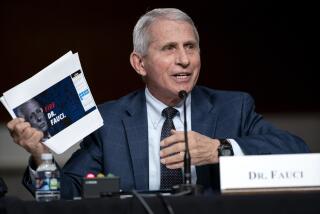Opinion: Gas stoves are bad for your health. So is the industry’s Big Tobacco-style coverup

In 1976, beloved chef, cookbook author and television personality Julia Child returned to WGBH-TV’s studios in Boston for a new cooking show, “Julia Child & Company,” following her hit series “The French Chef.” Viewers probably didn’t know that Child’s new and improved kitchen studio, outfitted with gas stoves, was paid for by the American Gas Assn.
While this may seem like any corporate sponsorship, we now know it was a part of a calculated campaign by gas industry executives to increase use of gas stoves across the United States. And stoves weren’t the only objective. The gas industry wanted to grow its residential market, and homes that used gas for cooking were likely also to use it for heat and hot water.
The industry’s efforts went well beyond careful product placement, according to new research from the nonprofit Climate Investigations Center, which analyzes efforts to undermine climate science and slow the transition away from fossil fuels. As the center’s study and a National Public Radio investigation show, when evidence emerged in the early 1970s about the health effects of indoor nitrogen dioxide exposure from gas stove use, the American Gas Assn. launched a campaign designed to manufacture doubt about the existing science.
Turning on one gas stove burner for 45 minutes creates benzene levels in kitchens comparable to breathing in cigarette smoke, which then drifts through your whole house.
The gas industry’s multipronged strategy related to gas stoves directly mirrored tactics that the tobacco industry used to undermine and distort scientific evidence of health risks associated with smoking starting in the 1950s.
It relied on Hill & Knowlton, the same public relations company that directed the tobacco industry’s playbook for responding to research linking smoking to lung cancer. The tactics used included sponsoring research that would counter scientific findings about gas stoves, emphasizing uncertainty in those findings to construct artificial controversy and engaging in aggressive public relations efforts.
For example, the gas industry obtained and reanalyzed the data from an EPA study on Long Island that showed more respiratory problems in homes with gas stoves. Its reanalysis concluded that there were no significant differences in respiratory outcomes.
Gas stoves may emit unhealthful pollutants even when not in use, a study finds. High levels of cancer-causing benezene were found in Southern California.
The industry also funded its own health studies in the early 1970s, which confirmed large differences in nitrogen dioxide exposures but did not show significant differences in respiratory outcomes. Those findings were published without disclosing the industry funding. Those conclusions were amplified in numerous conferences and ultimately influenced major governmental reports summarizing the state of the literature.
This campaign was remarkable, since the basics of how gas stoves affected indoor air pollution and respiratory health were straightforward and well established at the time. Burning fuel, including natural gas, generates nitrogen oxides. Nitrogen dioxide is known to adversely affect respiratory health. Inhaling it causes respiratory irritation and can worsen diseases such as asthma. This is a key reason why the U.S. Environmental Protection Agency established an outdoor air quality standard for nitrogen dioxide in 1971.
California is committing to a plan that will make it the first U.S. state to phase out gas-fueled furnaces and water heaters in homes.
No such standards exist for indoor air, but as the EPA now acknowledges, nitrogen dioxide exposure indoors is also harmful.
The key question is whether nitrogen dioxide exposure from gas stoves is large enough to lead to health concerns. While levels vary across homes, scientific research shows that the simple answer is yes — especially in smaller homes and when ventilation is inadequate.
This has been known for a long time. For example, a 1998 study that I co-authored showed that the presence of gas stoves was the strongest predictor of personal exposure to nitrogen dioxide. And research dating back to the 1970s found that indoor nitrogen dioxide levels in the presence of gas stoves could be far higher than outdoor levels. Depending on ventilation levels, concentrations could reach levels known to contribute to health risks.
Despite this evidence, the gas industry’s campaign was largely successful. Industry-funded studies muddied the waters and helped to stall further federal investigations or regulations addressing gas stove safety.
This issue took on new life in late 2022, when researchers published a new study estimating that 12.7% of U.S. cases of childhood asthma — about one case in eight — were attributable to gas stoves. Yet the industry continues to cast doubt on gas stoves’ contribution to health effects and fund pro-gas stove media campaigns.
Residential gas use also slows the shift toward renewable energy. Some cities have already moved or are considering steps to ban gas stoves in new construction and shift toward electrifying buildings.
As communities wrestle with these questions, regulators, politicians and consumers need accurate information about the risks of gas stoves and other products in homes. There is room for vigorous debate that considers a range of evidence, but the public has a right to know where that evidence comes from.
The commercial interests of many industries, including alcohol, tobacco and fossil fuels, aren’t always compatible with the public interest or human health. Exposing the tactics that vested interests use to manipulate the public can at least make consumers and regulators savvier and help deter other industries from using the same playbook.
Jonathan Levy is professor and chair of the Department of Environmental Health at Boston University School of Public Health. This article was produced in partnership with The Conversation.
More to Read
A cure for the common opinion
Get thought-provoking perspectives with our weekly newsletter.
You may occasionally receive promotional content from the Los Angeles Times.












